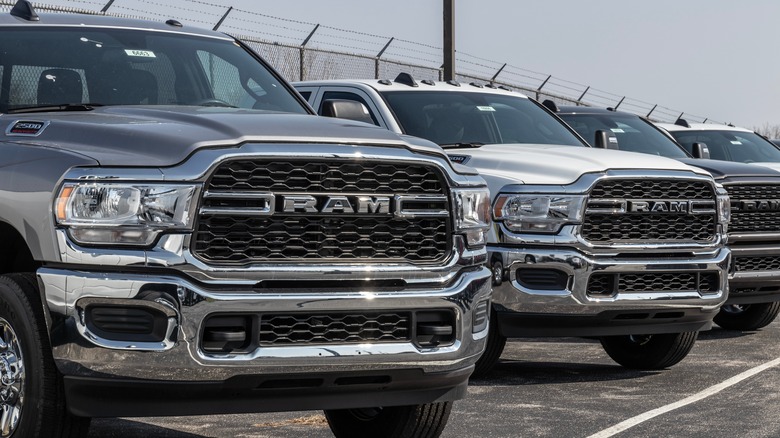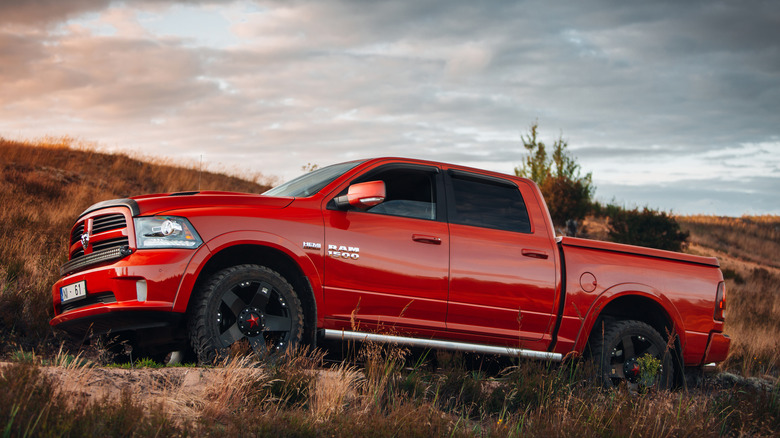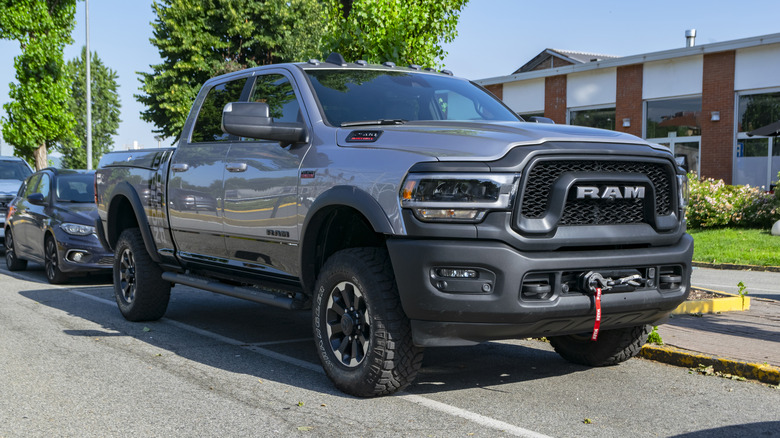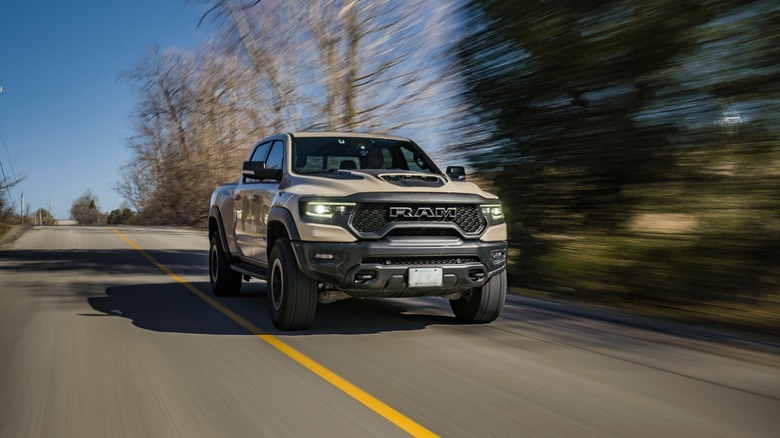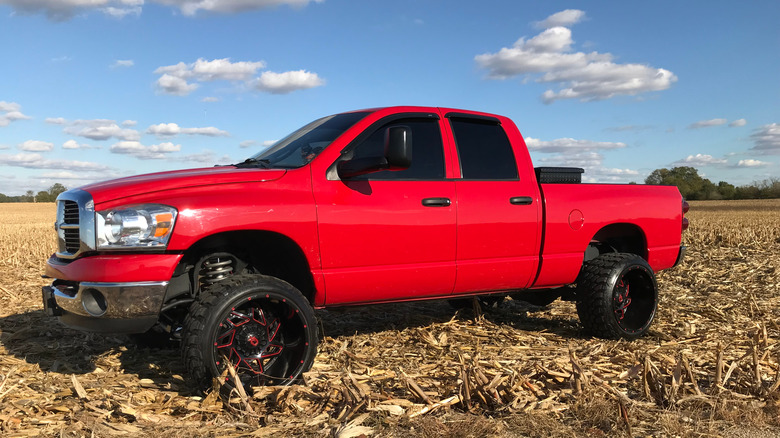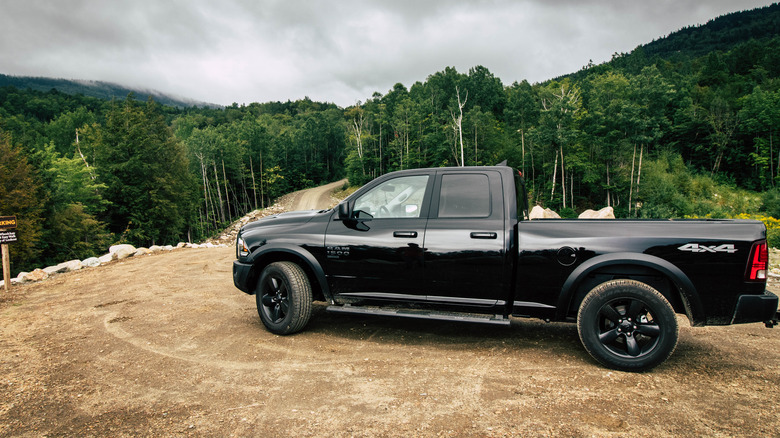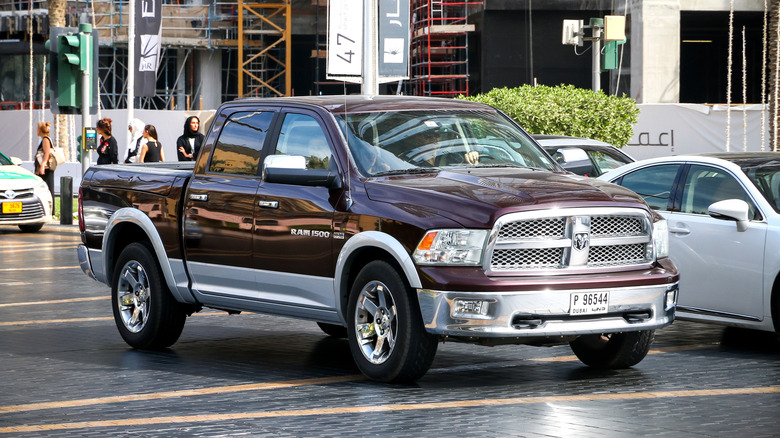RAM 1500 Vs. 2500: Big Differences To Know Before You Buy
RAM trucks have been around for a long time. They started as part of the Dodge brand but became their own thing in 2009. Since then, RAM has focused on making great trucks — like the RAM 1500 and 2500.
The RAM 1500 is what we call a light-duty truck. It's perfect for everyday tasks and is comfortable to drive. It's got enough power for most jobs and is good for both work and fun. The RAM 2500, on the other hand, is a heavy-duty truck. It's stronger and can tow more. This truck is for tougher jobs and competes with big names like the Ford F-250 and the Chevy Silverado 2500HD.
Both trucks are strong and reliable, but they serve different purposes, and if you're thinking about buying a pickup truck, it's important to know the differences between the RAM 1500 and the RAM 2500. To that end, we've used trusted sources like Car and Driver and MotorTrend to give you the best information before you buy.
In this article, we'll look at how powerful they are, what the inside looks like, how much they can tow, and their overall value. Whether you need a truck for work, adventures, or just for daily tasks, knowing these differences is key to choosing the right one.
What is the RAM 1500?
The RAM 1500 is a popular truck with a long history. It started as part of Dodge in the 1980s and became its own brand under Ram Trucks in 2010. This truck is known for being easy to drive and having great features, making it stand out in the world of big trucks.
Over the years, the 1500 has changed a lot, too. The first trucks in the 1980s were boxy and simple. Then, in the 1990s, they got bigger and more comfortable. Today, the latest models are even more spacious and stylish, with two types of cabins: quad and crew.
The RAM 1500 has always been strong under the hood as well. The 2011 model, in particular, was a big deal because it came with different engines, including a powerful V8. The newest models are even better — these engines are fuel efficient and are even partly electric. The RAM 1500 TRX, which was discontinued in 2023, is a notable 1500 with a huge 702-hp engine.
In the future, the RAM 1500 seems to be going electric, with the new RAM 1500 REV coming in 2025. It promises to go 350 miles on a single charge and can tow up to 14,000 pounds.
What is the RAM 2500?
Back in 1994, when it started life as the Dodge Ram 2500, this truck wasn't just your average pickup — it had some serious muscle under the hood. You could choose from a couple of V8 engines or a really powerful 5.9-liter straight-six Cummins turbo diesel engine; the latter quickly became a fan favorite for its remarkable torque and towing ability.
In 2002, things got even more interesting. The RAM 2500 got a makeover. It looked smoother and more modern. Plus, it got a new engine — the Hemi V8. This engine was a hit. Then, in 2010, the RAM 2500 changed again. It looked tougher and got even better on the inside. It kept the great Hemi V8 engine and added an even more powerful diesel option. It had different styles, too, so more people could find one they liked.
Now that we know both trucks, who is RAM 2500 for? If you need a truck that can handle tough jobs, like towing big things or driving over rough ground, this is for you. It's really strong and reliable. But if you just need a truck to drive around the city, this might be too much truck.
Performance
Performance might be the one area in which these two trucks differ from each other the most. The RAM 1500 has two engine choices — a 305-hp 3.6-liter V6 or a 395-hp 5.7-liter V8, both complemented by a 48-volt hybrid system. The 5.7-liter V8 is also available without the hybrid addition. The RAM 2500 is more powerful. It starts with a 410-hp 6.4-liter V-8, delivering 429 pound-feet of torque. For those craving more grunt, a 6.7-liter Cummins diesel inline-six is available with the 2500, with two power levels, peaking at 1,075 pound-feet of torque in the high-output version. This makes the 2500 a beast for heavy-duty tasks.
The towing power of the RAM 1500 is noteworthy, maxing out at 12,750 pounds, which is impressive for a light-duty truck. However, the RAM 2500 is in a different league, with a towing capacity of up to 19,010 pounds with the 2500 4x4 Crew Cab model equipped with the high-output Cummins engine. Similarly, payload capacities also vary significantly, with the 1500 capable of up to 2,320 pounds, while the 2500 can handle up to 3,240 pounds.
If you need a truck for daily tasks, some towing, and fun off-road, the RAM 1500 is great. It's versatile and not too big. If you often do heavy work, like towing big trailers or carrying a lot of weight, you might find the RAM 2500 to be much better.
Features
Starting from the interior, the 1500 is a mix of practical and fancy. It has lots of room inside, and the back seats are really spacious. You'll find fancy touches in the higher models, like nice leather and wood, heated seats, and even a big sunroof. But the 2500 offers even more luxury. It comes with diverse cabin options, including the colossal Mega Cab. The top Longhorn trim features details like striped wood and gold accents. Acoustic glass and active noise cancellation for a serene cabin experience. It's more akin to a high-end SUV, which is also reflected in its price, but that's for later.
Both trucks have great infotainment systems. They have a touchscreen (big or really big, your choice) and are compatible with Apple CarPlay and Android Auto by default. But, it's worth noting that some people have had problems with the bigger screen on previous models.
When it comes to safety and driver-assistance features, the RAM 1500 offers a range of features like blind-spot monitoring, automatic high-beam headlights, and adaptive cruise control. The RAM 2500 matches its counterpart in safety features, including forward-collision warning and automated emergency braking. The 2500 is a reliable choice for those prioritizing safety, though it slightly lags behind the 1500 in overall NHTSA ratings.
Price and value
The 2024 RAM 1500 starts at a more accessible price point of $41,500, escalating to about $67,800 with additional trims and options. On the other hand, the RAM 2500 starts at $49,700 and can go as high as $91,400. Value doesn't depend on price alone — fuel efficiency and warranties should also be part of your buying decision.
The RAM 1500 is better on gas. It can get up to 25 miles per gallon on the highway. The RAM 2500 doesn't have a gas mileage rating from the EPA because it's a bigger, commercial-type truck. But in real tests by Car and Driver, it got around 18 miles per gallon on the highway, which is pretty great for a big truck.
Both models offer a three-year or 36,000-mile limited warranty. The RAM 1500's powertrain warranty covers five years or 50,000 miles, while the RAM 2500 offers a slightly better deal, especially for the diesel variant, which extends to five years or 100,000 miles. But neither truck comes with free maintenance, which some competitors offer.
The bottom line is that the RAM 1500 is less expensive and saves on gas. It's perfect for normal use or small jobs. The RAM 2500 is for people who need to tow heavy stuff or use it for tough jobs. It costs more and uses more gas, but it's stronger if that's what you need.
Methodology
When comparing vehicles like the RAM 1500 and 2500, the ideal approach would undoubtedly be to get behind the wheel and test their mettle on the open road. Bar that, the next best thing is to turn to those who have — in this case, Car and Driver and MotorTrend.
Car and Driver has a great reputation when it comes to car reviews. They have been around since 1955 as a car culture print magazine and over 20 years as a digital magazine. While they test all the subjective aspects of a car — how it drives, what it feels like inside — they also collect over 200 data points on every test vehicle for detailed and accurate assessments. MotorTrend has been a go-to place for car lovers since 1949, too. They cover the industry more broadly than many of the instrument tests that other publications do, but you can also find them doing in-depth reviews on some vehicles like the RAMs.
Both outlets follow high editorial standards and provide independently produced, fact-checked, and technical accuracy information. Besides these primary sources, we also used tech specs published by the manufacturer and what owners had to say about the RAMs on dedicated pickup truck forums throughout this article.
